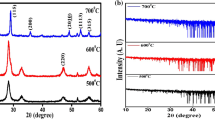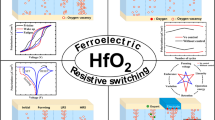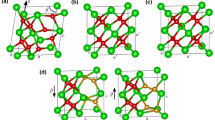Abstract
The poor endurance of the ferroelectric (FE) HfO2 (Fe-HfO2) material-based FE field-effect transistor (Fe-FET) remains a major challenge for its future commercial production. Here we propose a high-κ interface seed layer (SL) in the metal-FE-insulator-semiconductor (MFIS) gate stack to address this issue. We fabricated Hf0.5Zr0.5O2 (HZO) FE thin films on various high-κ dielectric SLs, including ZrO2, HfO2, (HfO2)0.75(Al2O3)0.25 (HAO), and Al2O3, and investigated their microstructures, ferroelectricity, and memory characteristics in the MFIS devices. The results show that the nucleation and growth of the FE orthorhombic phase in HZO films are affected not only by the surface energy but also by the microstructure of the high-κ SL. Additionally, we clarified the role of the high-κ SL on the memory characteristics of the MFIS devices, which were reasonably explained by the accurately calculated interface electric field. Finally, we realized a good tradeoff between the FE polarization and interface charge injection in the MFIS device with HAO high-κ SL, demonstrating a large FE window (> 1.0 V), excellent retention (> 1.6×104 s), and endurance cycles (> 105). The results will provide valuable ideas to overcome the challenge of endurance in the Fe-HfO2-based FeFET and contribute to developing other high-performance electron devices with Fe-HfO2 films grown on a dielectric SL.
摘要
HfO2基材料铁电场效应晶体管(FeFET)商业化应用面临的一个 重要挑战是其疲劳特性差. 本文提出, 在基于金属-铁电-绝缘层-半导体 (MFIS)栅叠层结构的FeFET中研发合适的高κ界面晶籽层(SL)以大幅度 提升其疲劳性能. 我们在ZrO2, HfO2, (HfO2)0.75(Al2O3)0.25 (HAO)和Al2 O3等典型的高κ介电SL上制备了Hf0.5Zr0.5O2 (HZO)铁电薄膜, 系统研究 了HZO薄膜的微观结构、铁电性及其MFIS器件的存储特性. 首先, 揭 示了HZO薄膜中铁电正交相的形核和生长不仅受高κ介电SL表面能的 影响, 而且其微观结构对HZO中正交相的形成也起到重要作用. 其次, 澄清了高κ介电晶籽层对MFIS结构存储特性的影响, 通过精确计算的 MFIS结构的界面层电场, 对MFIS结构的存储特性做出了合理解释. 最 后, 基于HAO的高κ SL的MFIS器件实现了铁电极化和界面电荷注入之 间的合理优化, 并且获得了较大铁电存储窗口(>1.0 V), 出色的保持特 性(>1.6 × 104 s)和疲劳特性(>105). 本文为未来解决HfO2基FeFET的疲 劳问题提供了有价值的思路, 为在介电SL上生长HfO2铁电薄膜的其他 高性能电子器件的开发提供了参考.
Similar content being viewed by others
References
Böscke TS, Müller J, Bräuhaus D, et al. Ferroelectricity in hafnium oxide thin films. Appl Phys Lett, 2011, 99: 102903
Müller J, Yurchuk E, Schlösser T, et al. Ferroelectricity in HfO2 enables nonvolatile data storage in 28 nm HKMG. In: 2012 Symposium on VLSI Technology (VLSIT). Honolulu: IEEE, 2012. 25–26
McGuire FA, Lin YC, Price K, et al. Sustained sub-60 mV/decade switching via the negative capacitance effect in MoS2 transistors. Nano Lett, 2017, 17: 4801–4806
Liu H, Lu T, Li Y, et al. Flexible quasi-van der Waals ferroelectric hafnium-based oxide for integrated high-performance nonvolatile memory. Adv Sci, 2020, 7: 2001266
Kim MK, Lee JS. Ferroelectric analog synaptic transistors. Nano Lett, 2019, 19: 2044–2050
Müller J, Bösckee T S, Müllera S, et al. Ferroelectric hafnium oxide: A CMOS-compatible and highly scalable approach to future ferroelectric memories. In: 2013 IEEE International Electron Devices Meeting. Washington: IEEE, 2013
Cheema SS, Kwon D, Shanker N, et al. Enhanced ferroelectricity in ultrathin films grown directly on silicon. Nature, 2020, 580: 478–482
Sang X, Grimley ED, Schenk T, et al. On the structural origins of ferroelectricity in HfO2 thin films. Appl Phys Lett, 2015, 106: 162905
Müller J, Böscke TS, Schröder U, et al. Ferroelectricity in simple binary ZrO2 and HfO2. Nano Lett, 2012, 12: 4318–4323
Park MH, Lee YH, Kim HJ, et al. Ferroelectricity and antiferroelectricity of doped thin HfO2-based films. Adv Mater, 2015, 27: 1811–1831
Joh H, Anoop G, Lee WJ, et al. Low-temperature growth of ferroelectric Hf0.5Zr0.5O2 thin films assisted by deep ultraviolet light irradiation. ACS Appl Electron Mater, 2021, 3: 1244–1251
Wang D, Zhang Y, Wang J, et al. Enhanced ferroelectric polarization with less wake-up effect and improved endurance of Hf0.5Zr0.5O2 thin films by implementing W electrode. J Mater Sci Tech, 2022, 104: 1–7
Kim HJ, Park MH, Kim YJ, et al. Grain size engineering for ferroelectric Hf0.5Zr0.5O2 films by an insertion of Al2O3 interlayer. Appl Phys Lett, 2014, 105: 192903
Lin YC, McGuire F, Franklin AD. Realizing ferroelectric Hf0.5Zr0.5O2 with elemental capping layers. J Vac Sci Technol B, 2018, 36: 011204
Park MH, Lee DH, Yang K, et al. Review of defect chemistry in fluorite-structure ferroelectrics for future electronic devices. J Mater Chem C, 2020, 8: 10526–10550
Zhang Y, Fan Z, Wang D, et al. Enhanced ferroelectric properties and insulator-metal transition-induced shift of polarization-voltage hysteresis loop in VOx-capped Hf0.5Zr0.5O2 thin films. ACS Appl Mater Interfaces, 2020, 12: 40510–40517
Kim SJ, Mohan J, Summerfelt SR, et al. Ferroelectric Hf0.5Zr0.5O2 thin films: A review of recent advances. JOM, 2018, 71: 246–255
Lehninger D, Ellinger M, Ali T, et al. A fully integrated ferroelectric thin-film-transistor-influence of device scaling on threshold voltage compensation in displays. Adv Electron Mater, 2021, 7: 2100082
Chernikova AG, Kozodaev MG, Negrov DV, et al. Improved ferroelectric switching endurance of La-doped Hf0.5Zr0.5O2 thin films. ACS Appl Mater Interfaces, 2018, 10: 2701–2708
Park MH, Lee YH, Kim HJ, et al. Surface and grain boundary energy as the key enabler of ferroelectricity in nanoscale hafnia-zirconia: A comparison of model and experiment. Nanoscale, 2017, 9: 9973–9986
Materlik R, Künneth C, Kersch A. The origin of ferroelectricity in Hf1−xZrxO2: A computational investigation and a surface energy model. J Appl Phys, 2015, 117: 134109
Zhang Y, Wang D, Luo C, et al. Controllable coercive field of ferroelectric HfO2 films via UV-ozone surface modification. IEEE Trans Electron Devices, 2022, 69: 3094–3099
Tang YT, Fan CL, Kao YC. A comprehensive kinetical modeling of polymorphic phase distribution of ferroelectric-dielectrics and interfacial energy effects on negative capacitance FETs. In: 2019 Symposium on VLSI Technology. Kyoto: IEEE, 2019. T222–T223
Kim H, Yun S, Kim TH, et al. Effect of hydrogen on hafnium zirconium oxide fabricated by atomic layer deposition using H2O2 oxidant. Phys Rapid Res Lett, 2021, 15: 2100020
Tian F, Zhao S, Xu H, et al. Impact of interlayer and ferroelectric materials on charge trapping during endurance fatigue of FeFET with TiN/HfxZr1−xO2/interlayer/Si (MFIS) gate structure. IEEE Trans Electron Devices, 2021, 68: 5872–5878
Xiao W, Liu C, Peng Y, et al. Memory window and endurance improvement of Hf0.5Zr0.5O2-based FeFETs with ZrO2 seed layers characterized by fast voltage pulse measurements. Nanoscale Res Lett, 2019, 14: 254
Si M, Su CJ, Jiang C, et al. Steep-slope hysteresis-free negative capacitance MoS2 transistors. Nat Nanotech, 2018, 13: 24–28
Wang JL, Guo XY, Yu ZH, et al. Steep slope p-type 2D WSe2 field-effect transistors with van der Waals contact and negative capacitance. In: 2018 IEEE International Electron Devices Meeting (IEDM). San Francisco: IEEE, 2018
Ali T, Sünbül A, Mertens K, et al. Impact of the ferroelectric and interface layer optimization in an MFIS HZO based ferroelectric tunnel junction for neuromorphic based synaptic storage. In: 2021 Silicon Nanoelectronics Workshop (SNW). Kyoto: IEEE, 2022. 1–2
Xiao W, Liu C, Peng Y, et al. Performance improvement of Hf0.5Zr0.5O2-based ferroelectric-field-effect transistors with ZrO2 seed layers. IEEE Electron Device Lett, 2019, 40: 714–717
Onaya T, Nabatame T, Sawamoto N, et al. Improvement in ferroelectricity of HfxZr1−xO2 thin films using ZrO2 seed layer. Appl Phys Express, 2017, 10: 081501
Onaya T, Nabatame T, Sawamoto N, et al. Improvement in ferroelectricity of HfxZr1−xO2 thin films using top- and bottom-ZrO2 nucleation layers. APL Mater, 2019, 7: 061107
Mueller S, Slesazeck S, Mikolajick T, et al. Next-generation ferroelectric memories based on FE-HfO2. In: 2015 Joint IEEE International Symposium on the Applications of Ferroelectric (ISAF), International Symposium on Integrated Functionalities (ISIF), and Piezoelectric Force Microscopy Workshop (PFM). Singapore: IEEE, 2015. 233–236
Meena JS, Sze SM, Chand U, et al. Overview of emerging nonvolatile memory technologies. Nanoscale Res Lett, 2014, 9: 526
Khan AI, Keshavarzi A, Datta S. The future of ferroelectric field-effect transistor technology. Nat Electron, 2020, 3: 588–597
Lu X, Maruyama K, Ishiwara H. Metal-ferroelectric-insulator-Si devices using HfTaO buffer layers. Semicond Sci Technol, 2008, 23: 045002
Luo Q, Gong T, Cheng Y, et al. Hybrid 1T e-DRAM and e-NVM realized in one 10 nm node ferro FinFET device with charge trapping and domain switching effects. In: 2018 IEEE International Electron Devices Meeting (IEDM). San Francisco: IEEE, 2018
Ali T, Kühnel K, Mertens K, et al. Effect of substrate implant tuning on the performance of MFIS silicon doped hafnium oxide (HSO) FeFET memory. In: 2020 IEEE International Memory Workshop (IMW). Dresden: IEEE, 2020. 1–4
Chan CY, Chen KY, Peng HK, et al. FeFET memory featuring large memory window and robust endurance of long-pulse cycling by interface engineering using high-κ AlON. In: 2020 IEEE Symposium on VLSI Technology. Honolulu: IEEE, 2020. 1–2
Ni K, Sharma P, Zhang J, et al. Critical role of interlayer in Hf0.5Zr0.5O2 ferroelectric FET nonvolatile memory performance. IEEE Trans Electron Devices, 2018, 65: 2461–2469
Tang MH, Sun ZH, Zhou YC, et al. Capacitance-voltage and retention characteristics of Pt/SrBi2Ta2O9/HfO2/Si structures with various buffer layer thickness. Appl Phys Lett, 2009, 94: 212907
Sakai S, Takahashi M. Recent progress of ferroelectric-gate field-effect transistors and applications to nonvolatile logic and FeNAND flash memory. Materials, 2010, 3: 4950–4964
Hsiang KY, Liao CY, Chen KT, et al. Ferroelectric HfZrO2 with electrode engineering and stimulation schemes as symmetric analog synaptic weight element for deep neural network training. IEEE Trans Electron Devices, 2020, 67: 4201–4207
Lee PF, Dai JY, Wong KH, et al. Study of interfacial reaction and its impact on electric properties of Hf-Al-O high-κ gate dielectric thin films grown on Si. Appl Phys Lett, 2003, 82: 2419–2421
Curreem KKS, Lee PF, Wong KS, et al. Comparison of interfacial and electrical characteristics of HfO2 and HfAlO high-κ dielectrics on compressively strained Si1−xGex. Appl Phys Lett, 2006, 88: 182905
George SM. Atomic layer deposition: An overview. Chem Rev, 2010, 110: 111–131
Sharma P, Tapily K, Saha A. K, et al. Impact of total and partial dipole switching on the switching slope of gate-last negative capacitance FETs with ferroelectric hafnium zirconium oxide gate stack. In: 2017 Symposium on VLSI Technology. Kyoto: IEEE, 2017. T154–T155
Schenk T, Fancher CM, Park MH, et al. On the origin of the large remanent polarization in La:HfO2. Adv Electron Mater, 2019, 5: 1900303
Huang C, Zhang Y, Zheng S, et al. Interface effects induced by a ZrO2 seed layer on the phase stability and orientation of HfO2 ferroelectric thin films: A first-principles study. Phys Rev Appl, 2021, 16: 044048
Janssen D, De Palma R, Verlaak S, et al. Static solvent contact angle measurements, surface free energy and wettability determination of various self-assembled monolayers on silicon dioxide. Thin Solid Films, 2006, 515: 1433–1438
Andrade JD, Smith LM, Gregonis DE. The contact angle and interface energetics, In: Andrade JD (ed). Surface and Interfacial Aspects of Biomedical Polymers. Boston: Springer, 1995. 249–292
Pešić M, Fengler FPG, Larcher L, et al. Physical mechanisms behind the field-cycling behavior of HfO2-based ferroelectric capacitors. Adv Funct Mater, 2016, 26: 4601–4612
Kashir A, Oh S, Hwang H. Defect engineering to achieve wake-up free HfO2-based ferroelectrics. Adv Eng Mater, 2021, 23: 2000791
Samanta S, Anoop G, Joh HJ, et al. Multi-step chemical solution deposition-annealing process toward wake-up free ferroelectricity in Y: HfO2 films. Adv Mater Interfaces, 2021, 8: 2100907
Srolovitz DJ. Grain growth phenomena in films: A Monte Carlo approach. J Vacuum Sci Tech A-Vacuum Surfs Films, 1986, 4: 2925–2931
Navrotsky A. Energetic clues to pathways to biomineralization: Precursors, clusters, and nanoparticles. Proc Natl Acad Sci USA, 2004, 101: 12096–12101
Bharti B, Kumar S, Kumar R. Superhydrophilic TiO2 thin film by nanometer scale surface roughness and dangling bonds. Appl Surf Sci, 2016, 364: 51–60
Zhang SB, Wei SH. Surface energy and the common dangling bond rule for semiconductors. Phys Rev Lett, 2004, 92: 086102
Luo YR. Comprehensive Handbook of Chemical Bond Energies. Boca Raton: CRC Press, 2007
Chen H, Tang L, Liu L, et al. Significant improvement of ferroelectricity and reliability in Hf0.5Zr0.5O2 films by inserting an ultrathin Al2O3 buffer layer. Appl Surf Sci, 2021, 542: 148737
Grimley ED, Schenk T, Sang X, et al. Structural changes underlying field-cycling phenomena in ferroelectric HfO2 thin films Adv Electron Mater, 2016, 2: 1600173
Park MH, Lee YH, Kim HJ, et al. Morphotropic phase boundary of Hf1−xZrxO2 thin films for dynamic random access memories. ACS Appl Mater Interfaces, 2018, 10: 42666–42673
Toprasertpong K, Lin ZY, Lee TE, et al. Asymmetric polarization response of electrons and holes in Si FeFETs: Demonstration of absolute polarization hysteresis loop and inversion hole density over 2×1013 cm−2. In: 2020 IEEE Symposium on VLSI Technolgy. Honolulu: IEEE, 2020. 1–2
Toprasertpong K, Tahara K, Takenaka M, et al. Evaluation of polarization characteristics in metal/ferroelectric/semiconductor capacitors and ferroelectric field-effect transistors. Appl Phys Lett, 2020, 116: 242903
Toprasertpong K, Tahara K, Fukui T, et al. Improved ferroelectric/semiconductor interface properties in Hf0.5Zr0.5O2 ferroelectric FETs by low-temperature annealing. IEEE Electron Device Lett, 2020, 41: 1588–1591
Mahata C, Byun YC, An CH, et al. Comparative study of atomic-layer-deposited stacked (HfO2/Al2O3) and nanolaminated (HfAlOx) dielectrics on In0.53Ga0.47As. ACS Appl Mater Interfaces, 2013, 5: 4195–4201
Gao J, He G, Sun Z, et al. Modification of electrical properties and carrier transportation mechanism of ALD-derived HfO2/Si gate stacks by Al2O3 incorporation. J Alloys Compd, 2016, 667: 352–358
Tasneem N, Islam MM, Wang Z, et al. The impacts of ferroelectric and interfacial layer thicknesses on ferroelectric FET design. IEEE Electron Device Lett, 2021, 42: 1156–1159
Li P, Huang Z, Fan Z, et al. An unusual mechanism for negative differential resistance in ferroelectric nanocapacitors: Polarization switching-induced charge injection followed by charge trapping. ACS Appl Mater Interfaces, 2017, 9: 27120–27126
Jin C, Saraya T, Hiramoto T, et al. Transient negative capacitance as cause of reverse drain-induced barrier lowering and negative differential resistance in ferroelectric FETs In: Symposium on VLSI Technolgy. Kyoto: IEEE, 2019. T220–T221
Cao R, Liu Q, Liu M, et al. Improvement of endurance in HZO-based ferroelectric capacitor using Ru electrode. IEEE Electron Device Lett, 2019, 40: 1744–1747
Wang J, Qin M, Zeng M, et al. Excellent ferroelectric properties of Hf0.5Zr0.5O2 thin films induced by Al2O3 dielectric layer. IEEE Electron Device Lett, 2019, 40: 1937–1940
Zhang Y, Shao YY, Lu XB, et al. Defect states and charge trapping characteristics of HfO2 films for high performance nonvolatile memory applications. Appl Phys Lett, 2014, 105: 172902
Yurchuk E, Muller J, Muller S, et al. Charge-trapping phenomena in HfO2-based FeFET-type nonvolatile memories IEEE Trans Electron Devices, 2016, 63: 3501–3507
Lu X, Maruyama K, Ishiwara H. Characterization of HfTaO films for gate oxide and metal-ferroelectric-insulator-silicon device applications. J Appl Phys, 2008, 103: 044105
Min DH, Kang SY, Moon SE, et al. Impact of thickness control of Hf0.5Zr0.5O2 films for the metal-ferroelectric-insulator-semiconductor capacitors IEEE Electron Device Lett, 2019, 40: 1032–1035
Acknowledgements
This work was supported by the National Natural Science Foundation of China (62174059, 51872099, and 91963102), Hong Kong Research Grant Council (15300619), Science and Technology Program of Guangzhou (201905-0001), Guangdong Science and Technology Project-International Cooperation (2021A0505030064), the Program for Chang Jiang Scholars and Innovative Research Teams in Universities (IRT_17R00), and the 111 Project
Author information
Authors and Affiliations
Contributions
Lu X designed and supervised this work. Zhang Y carried out the thin film preparation, sample fabrication, and electrical measurements. Dai JY helped with the microstructure characterizations. Zhang Y, Wang D, Wang J, Luo C, Li M, and Li Y conducted the XRD and XRR. Zhang Y and Tao R performed the measurement of AFM and contact angles. Zhang Y and Lu X wrote the manuscript. All authors read and commented on the manuscript.
Corresponding author
Additional information
Conflict of interest
The authors declare that they have no conflict of interest.
Supplementary information
Supporting data are available in the online version of thepaper.
Yan Zhang is currently working as a PhD student at South China Academy of Advanced Optoelectronics, South China Normal University. His research interests focus on the ferroelectric materials and their applications in memory devices.
Xubing Lu received his PhD degree from Nanjing University in 2002. From 2002 to 2010, he worked as postdoctoral researcher, JSPS research fellow and Humbolt researcher in several universities and research institutions in China and abroad. He has been working at South China Normal University as a full professor since 2010. His research interests include high-κ dielectric materials, ferroelectric materials, and their applications in nonvolatile memory devices and artificial synaptic devices.
Supporting Information
40843_2022_2124_MOESM1_ESM.pdf
Growth of the orthorhombic phase and inhibition of charge injection in ferroelectric HfO2-based MFIS memory devices with a high-permittivity dielectric seed layer
Rights and permissions
About this article
Cite this article
Zhang, Y., Wang, D., Wang, J. et al. Growth of the orthorhombic phase and inhibition of charge injection in ferroelectric HfO2-based MFIS memory devices with a high-permittivity dielectric seed layer. Sci. China Mater. 66, 219–232 (2023). https://doi.org/10.1007/s40843-022-2124-7
Received:
Accepted:
Published:
Issue Date:
DOI: https://doi.org/10.1007/s40843-022-2124-7




